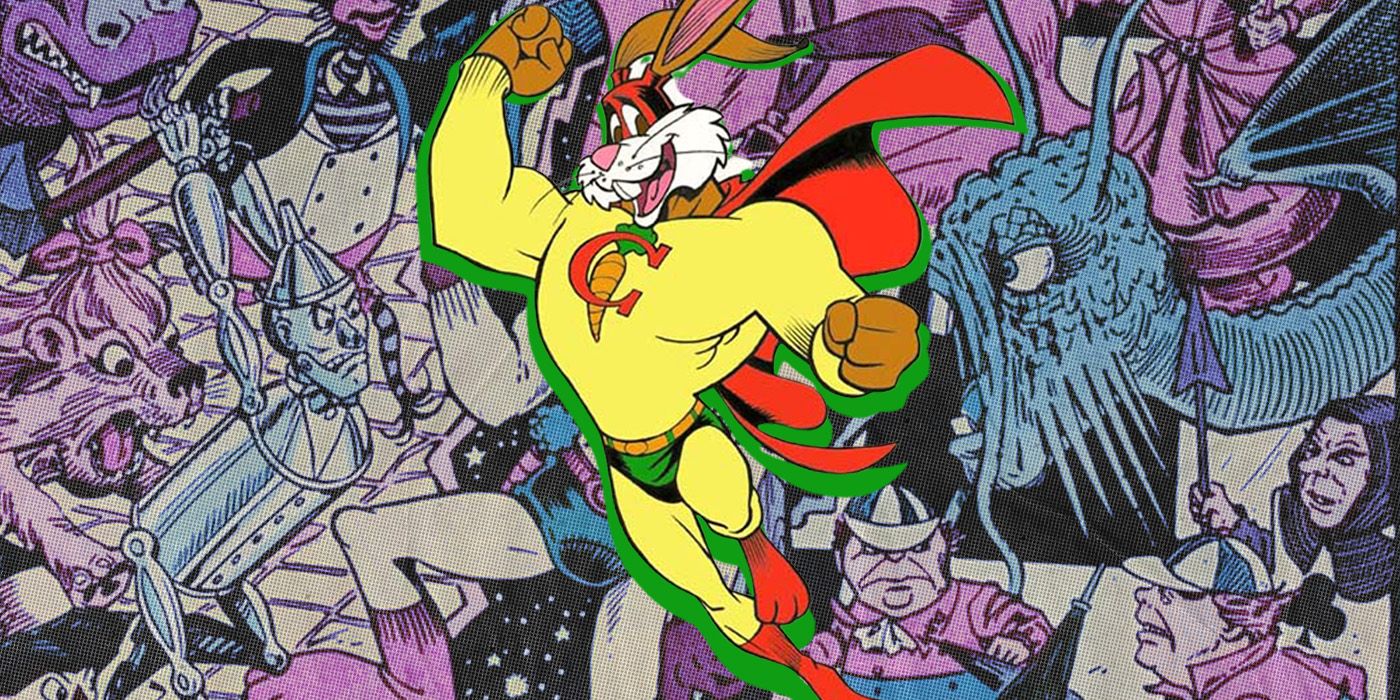Summary
DC Comics is beloved by many for its core universe of heroes and villains. However, the company has also earned respect from fans for its treatment of other properties, and has produced plenty of great comics based on treasured stories from classic literature. However, Captain Carrot: The Oz-Wonderland War (by E. Nelson Bridwell, Joey Cavalieri and Carol Lay) was a fun comic that could have been so much better with a little more substance.
Captain Carrot: The Oz-Wonderland War was released in 1986, and combined two classic works of fiction in L. Frank Baum’s The Wizard of Oz and Lewis Carroll’s Alice in Wonderland. With DC’s own whimsical superhero Captain Carrot at the heart of the story, it followed a journey through both worlds and their characters on a quest for freedom from an evil king. A classic quest for freedom, the story was written to be a fun read for kids who loved both stories. Unfortunately, the well-intentioned story was weighed down by needless references to the original stories, excessive fan service, and inconsequential challenges. What could have been a wonderful ode to classic literature and a conclusion to a forgotten comic instead came across as little more than a sordid collection of self-referential one-liners.
RELATED: 10 Marvel And DC Teams That Are Almost The Same
DC’s Oz-Wonderland War, Explained
The Oz-Wonderland War united three great, fantastical worlds in a single comic book trilogy, The Wizard of Oz, Alice in Wonderland and DC’s own Captain Carrot and his Zoo Crew. The series revolved around a “crisis” of sorts, which necessitated the crossover between Carroll’s Wonderland and Baum’s Oz. After being recruited by the Cheshire Cat for assistance, the Zoo Crew ventured into Wonderland, where they were met with and joined the Red Queen. As they pushed on, meeting more of the Wonderland characters, they soon found themselves at last in the Merry Old Land of Oz. Despite its name, The Oz-Wonderland War isn’t actually the story of a conflict between the two fantasy worlds. Rather, it tells the tale of the team-up between the characters to take on the evil Roquat, the Nome King, who has taken control of the Wicked Witch’s flying monkeys.
In possession of a magical belt, Roquat imprisoned the rightful rulers of Oz, taking the land for himself. It was revealed to the Zoo Crew that these rulers, such as the Wizard and Gilda, had been transformed into MacGuffins, basically becoming items in a scavenger hunt for the team to restore to their former selves. Thus, the heroes embarked on their mission to find each of these hidden characters and put them back to normal, so they could gather forces to depose Roquat and save Wonderland from invasion. As the heroes made their way through Oz, they met with Dorothy, who joined them in their quest to save the lost leaders of the land, with side characters revealing useful pieces of information to help them.
From the Deadly Poppy Field in which Dorothy and her companions were once incapacitated to the Wicked Witch of the West’s castle, the heroes pushed on in pursuit of their trapped allies. The evil king Roquat was watching them through his magic picture, where he could see but not hear his adversaries, giving them an advantage. The king, enraged by the team’s progress, unleashed a slew of challenges upon them, such as his evil flying monkeys and a cavalcade of other fictional beings. However, the heroes remained undeterred. In the end all the heroes were restored to their true form, with Princess Ozma being the final one in need of rescue, and whom Gilda restored from Roquat’s crown. However, the story, true to form for a children’s fairytale, ended with the villain not killed, rather fleeing with an underwhelming threat to return.
RELATED: 10 Comics Where The Justice League Teamed Up With Their Alternate Universe Counterparts
The Problems With DC’s Oz-Wonderland War
The Oz-Wonderland War, despite being a great idea, suffered from a few issues that made it a one-note, forgettable story. One of the series’ biggest issues was the non-stop, punchy one-liners. Just about every Oz, Wonderland or animal-related pun imaginable made its way into the story. In fact, it was even commented on by the characters themselves, though they’d immediately revert into these one-liners themselves. The puns even made their way into the plot itself, best demonstrated by a nonsensical train of thought by Captain Carrot that helped him solve the mystery of the Cowardly Lion’s disguise. The writing would have been perfectly at home in a Hanna-Barbera Wacky Races episode, but it ultimately diminished the value of a series that should have been an homage to classic literature. The incredibly underwhelming and overly-hasty conclusion and misleading name certainly doesn’t help either.
Due to the fact the series was limited to a meager three issues, there wasn’t much room for a meaningful story or any real character development. Each challenge with which the Zoo Crew was presented was overcome relatively quickly, and even their interpersonal drama was resolved within a few pages. Whether it was Pig-Iron threatening to quit the team or the flirtations between Alley-Kat-Abra, readers were presented with intriguing drama only for it to go unresolved or hand-waved away instantly. This left very little in the way of good action from the Zoo Crew or mystery-solving, both of which should have featured more prominently in the story. Some answers were handed to the characters in true “deus ex machina” fashion, completely ruining any chance to see these heroes work things out for themselves as they did in their original stories. It’s unclear how much of this was the fault of the writer or simply bad editorial direction.
The Oz-Wonderland War also wasted what should have been a strong conclusion to the story of Captain Carrot and his Amazing Zoo Crew. The team had been given a short-lived, twenty-issue series in 1982, but very little came of it once canceled, at least not until their three-way crossover with Oz and Wonderland. The kid-friendly, satirical spin on superheroes had very little in the way of any meaningful challenge, and the conflicts that Carrot didn’t handily deal with seemed to resolve themselves. Not only this, but very few characters had any real focus in the story beyond Carrot, Alley-Kat-Abra, Pig-Iron and Roquat, who himself was a one-note villain. For fans who just want to see these two classic worlds presented with good art, the three-issue miniseries is fine. However, for anyone looking for a substantive series that adds to either of its worlds, the series would be a disappointment.
RELATED: 10 Hero Mash-Ups We Want To See After SuperBat From World’s Finest
The Series Squandered A Great Concept
Despite a few enjoyable moments, Captain Carrot: The Oz-Wonderland War ultimately felt more like a greatest hits compilation of its three worlds than it did a fresh tale. As entertaining as it could be, much of the dialog read like punchy, one-liner taglines. Many of the plots felt simplified and didn’t make much sense. Rather than giving readers a story that felt as though it were populated by actual characters, each member of the cast had very little character development, and even the leading Captain Carrot had nothing of value added to his story. Every new interaction with the inhabitants of Oz and Wonderland was an extension of what had been seen before.
The Oz-Wonderland War is a good example of a story that was harmed by being overly-compressed and going all in on cheap and often patronizing dialog. Neither Carroll nor Baum’s works were written with the juvenile nature of this miniseries, and the script came across as too simplistic. Despite fantastic, thematically accurate art from Carol Lay, the story that tried to appeal to the market for all three properties instead came across as alienating. What could have been a fantastical journey into two of the most treasured worlds in classical literature was reduced to an episode of Looney Tunes, completely wasting otherwise incredible potential.
In 1986, DC united their whimsical Zoo Crew with the classic fantasy lands Oz and Wonderland. Despite a great idea, the series is wasted potential. Read More

